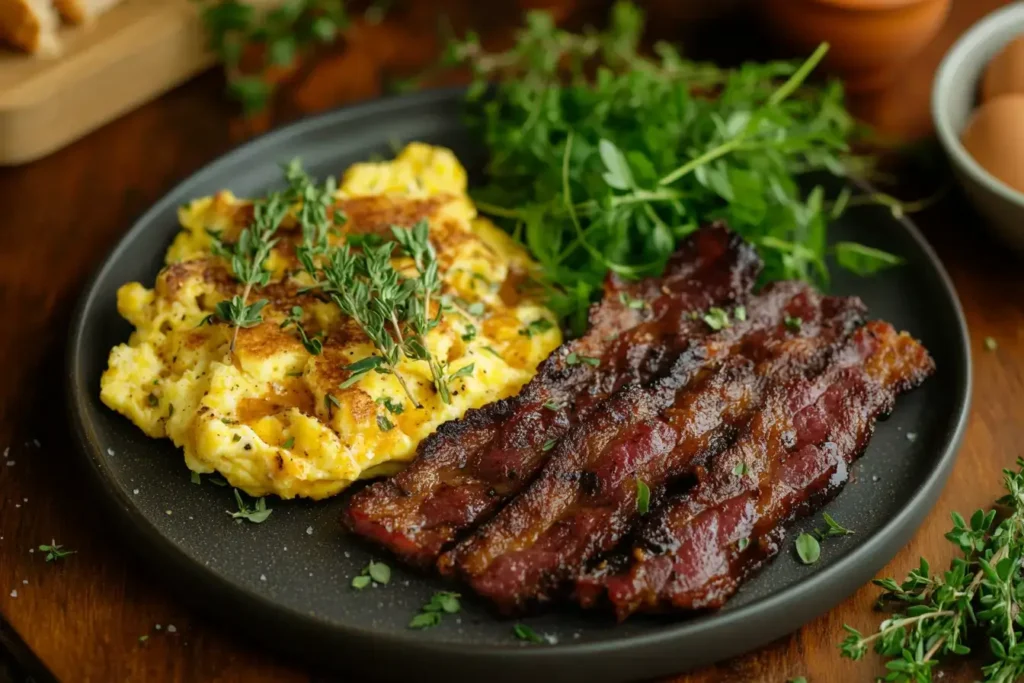Move over, pork—there’s a new crispy contender in town! If you love smoky, savory flavors but want something different, this pork-free alternative is worth exploring. Whether you’re trying it for dietary reasons, religious preferences, or just curiosity, this delicious option offers a unique twist on a classic favorite.
In this guide, we’ll cover everything from what it is and how it’s made to the best brands, recipes, and cooking methods. If you’ve ever wondered whether this smoky delight can replace the usual breakfast favorite, keep reading!
Table of Contents
What Is Beef Bacon?
Origins and History
This meat-based alternative may sound like a recent innovation, but it has been around for quite some time. While pork has long dominated breakfast plates, other cured meats have existed in various cultures. Many people looking for non-pork options have turned to this tasty substitute, which is made using a curing and smoking process similar to traditional bacon.
Unlike the familiar variety, this version comes from different beef cuts, typically brisket, belly, or round. The result? A meatier, slightly chewier bite with deep umami flavor.
How It Differs from Pork Bacon
The biggest difference? The cut of meat. Traditional pork bacon comes from the belly of a pig, which is fatty, tender, and easy to crisp up. Beef bacon, on the other hand, is typically made from:
- Beef belly – Similar to pork belly but leaner
- Brisket – Meatier with a deep, beefy flavor
- Round cuts – Less fatty but still flavorful
In terms of texture and taste, beef bacon is often:
- Meatier and denser than pork bacon
- Richer in umami flavor with a slightly smoky undertone
- Less fatty, making it crisp up differently when cooked
Why Beef Bacon Is Gaining Popularity
Several reasons contribute to beef bacon’s growing appeal:
✅ Dietary Restrictions – Many people avoid pork for religious, health, or ethical reasons. Beef bacon offers a tasty alternative.
✅ Health Benefits – Lower in fat and higher in protein, it appeals to fitness enthusiasts and keto dieters.
✅ Unique Taste – With a deeper, more robust flavor profile, it’s perfect for those who love a meaty bite.
✅ Gourmet Appeal – Chefs and food lovers are experimenting with beef bacon in burgers, sandwiches, and upscale dishes.
As more brands enter the market and homemade beef bacon recipes gain popularity, it’s clear that this alternative isn’t just a trend—it’s here to stay!
How It’s Made

The Best Cuts of Beef for Bacon
Unlike the traditional pork version, this savory meat alternative comes from different cuts, most commonly brisket, belly, or round. The process of curing and smoking is what gives it its distinct taste.
Curing – The meat is coated with a blend of salt, sugar, and spices to enhance flavor.
Drying – After curing, it’s left to rest for several hours or days, intensifying the taste.
Smoking – Traditionally, it’s smoked over hickory, applewood, or cherry wood, which gives it a deep, rich aroma.
Slicing – Once cured and smoked, it’s thinly sliced to resemble its pork counterpart.
For those who love making things from scratch, a homemade version allows for complete control over ingredients and flavors.
Commercial vs. Homemade
Store-bought beef bacon is widely available, with brands offering various flavors and smoking techniques. However, homemade beef bacon recipes provide more customization.
Pros of Store-Bought Beef Bacon:
✅ Convenient and ready to cook
✅ Consistent flavor and texture
✅ Available in different cuts and styles
Pros of Homemade Beef Bacon:
✅ Full control over ingredients
✅ Ability to experiment with seasonings and smoking woods
✅ No preservatives or artificial additives
For those wanting a DIY approach, making beef bacon at home is easier than you think!
Beef Bacon vs. Pork Bacon – A Detailed Comparison
Taste and Texture Differences
One of the biggest questions people ask is, “Does beef bacon taste like pork bacon?” The short answer: Not exactly, but it’s just as delicious!
- Beef bacon has a meatier texture with a deeper, umami-rich flavor.
- Pork bacon is sweeter, fattier, and crispier due to its high-fat content.
- The smoking and seasoning process heavily influences both flavors.
If you enjoy a heartier bite with a bold smoky taste, beef bacon might just win you over!
Nutritional Comparison
For health-conscious eaters, beef bacon offers some advantages over pork bacon. Here’s a quick breakdown:
| Nutrient | Beef Bacon (Per 100g) | Pork Bacon (Per 100g) |
|---|---|---|
| Calories | ~300-350 kcal | ~400-500 kcal |
| Protein | 20-25g | 12-15g |
| Fat | 20-30g | 35-45g |
| Sodium | Varies | Varies |
Beef bacon is higher in protein and lower in fat, making it a great choice for keto and high-protein diets.
Cooking Methods and Uses
Cooking this savory cut requires slightly different techniques due to its lower fat content. To get the best results:
Pan-frying – Use medium heat with a little oil to prevent sticking.
Baking – Arrange slices on a foil-lined tray at 375°F (190°C) and bake for 12-15 minutes.
Air frying – Cook at 350°F (175°C) for a crispy finish.
It works well in breakfast dishes, burgers, salads, and sandwiches. While pork tends to crisp up more due to its fat content, this version delivers a bold, smoky taste and pairs well with a variety of meals.
You can use beef bacon in:
- Breakfast dishes like omelets and scrambles
- Burgers and sandwiches for a smoky crunch
- Salads and pastas for added flavor
While pork bacon reigns supreme in crispiness, beef bacon delivers a heartier, bolder taste that makes it a fantastic alternative!
Health Benefits
This meat-based alternative is often praised for being higher in protein and lower in fat than pork varieties. Those following high-protein or low-carb diets appreciate its nutritional benefits without sacrificing flavor.
Here’s a quick look at how it stacks up:
| Nutrient | This Alternative (Per 100g) | Traditional Pork (Per 100g) |
|---|---|---|
| Calories | ~300-350 kcal | ~400-500 kcal |
| Protein | 20-25g | 12-15g |
| Fat | 20-30g | 35-45g |
| Sodium | Varies | Varies |
While this protein-rich cut can be a great addition to a balanced diet, it’s important to check labels for preservatives or added sodium in store-bought options.iet, it’s important to check labels for preservatives or added sodium in store-bought options.
How to Cook it
Best Cooking Methods
Cooking beef bacon is slightly different from pork bacon because it’s leaner. To achieve the best texture and flavor, try these methods:
Pan-Frying – Heat a non-stick skillet over medium heat, adding a little oil to prevent sticking. Cook for 4-5 minutes per side until crispy.
Baking – Preheat the oven to 375°F (190°C). Place strips on a foil-lined baking sheet and bake for 12-15 minutes, flipping halfway.
Air Frying – Set the air fryer to 350°F (175°C) and cook for 7-10 minutes, shaking the basket halfway for even crispiness.
Tips for Getting the Perfect Crisp
- Beef bacon doesn’t release as much fat as pork bacon, so adding a little oil or butter can help achieve a crispy texture.
- Cooking on medium heat prevents burning while allowing the meat to render properly.
- Let cooked bacon rest on paper towels to remove excess grease and enhance crispiness.
Common Mistakes to Avoid
Overcooking – Since beef bacon is leaner, it can dry out quickly if cooked too long.
Skipping the oil – A small amount of oil helps with browning and crisping.
Cooking on high heat – This can burn the edges while leaving the center undercooked.
Once you’ve mastered cooking beef bacon, try adding it to sandwiches, salads, or even pasta dishes for a smoky, savory twist!
Best Brands and Where to Buy
If you’re ready to try this smoky, flavorful option, many trusted brands offer high-quality varieties. Some of the best include:
- Godshall’s – A popular pick with a perfect balance of meat and fat.
- Wellshire Farms – Known for using natural ingredients and avoiding artificial nitrates.
- Porter Road – Offers dry-aged, gourmet-style cuts.
You can find this savory alternative at:
Local butchers – Fresh, hand-cut selections.
Supermarkets – Many major grocery chains stock it in the deli section.
Online stores – Sites like Amazon, ButcherBox, and specialty farms offer delivery.
For the best quality, look for grass-fed, nitrate-free options with minimal processing.
DIY Beef Bacon – How to Make It at Home

Step-by-Step Homemade Beef Bacon Recipe
If you love homemade flavors, making your own beef bacon is a fun and rewarding experience! Here’s a simple recipe to try at home:
Ingredients:
- 3 lbs beef belly (or brisket)
- ¼ cup kosher salt
- 2 tbsp brown sugar or honey
- 1 tbsp black pepper
- 1 tbsp paprika
- 1 tsp garlic powder
- 1 tsp onion powder
- ½ tsp cure #1 (optional for preservation)
- Wood chips (hickory or applewood) for smoking
Instructions:
- Prepare the Beef – Trim excess fat and place the beef in a large dish.
- Apply the Cure – Mix all the spices and rub them evenly over the meat. Cover and refrigerate for 5-7 days, flipping once daily.
- Rinse and Dry – After curing, rinse the beef thoroughly and pat dry. Let it sit in the fridge uncovered for 12-24 hours to form a pellicle (a sticky surface that helps with smoking).
- Smoke the Bacon – Preheat your smoker to 200°F (93°C) and smoke the beef for 2-3 hours until the internal temperature reaches 150°F (65°C).
- Slice and Cook – Once cooled, slice thinly and pan-fry, bake, or air-fry as you would with regular bacon!
Storage and Shelf Life Tips
- Refrigerate raw, cured beef bacon for up to 2 weeks.
- Freeze sliced bacon for up to 3 months in an airtight container.
- Vacuum-seal for extended freshness.
Making your own beef bacon allows you to customize flavors and control ingredients, ensuring a tasty, homemade alternative to store-bought versions!
Conclusion
Beef bacon is a delicious, smoky, and protein-rich alternative to traditional pork bacon. Whether you’re looking for a healthier option, a pork-free alternative, or just something new to try, beef bacon delivers bold flavor and versatility in countless dishes. From breakfast plates to burgers and gourmet recipes, this meaty delight can easily become a staple in your kitchen.
Now that you know how to cook it, where to buy it, and even how to make it at home, it’s time to give beef bacon a try! Whether crispy or chewy, its rich taste and hearty texture are sure to impress. So, what are you waiting for? Fire up that skillet and enjoy some delicious beef bacon today!
For more recipes, visit www.loversofrecipes.com
FAQs
Is Beef Bacon Healthier Than Pork Bacon?
It depends! Beef bacon is often higher in protein and lower in fat than pork bacon, making it a good choice for high-protein diets. However, some store-bought versions may contain added sodium and preservatives, so always check the label.
Does Beef Bacon Taste Like Pork Bacon?
Not exactly. Beef bacon has a meatier, richer taste with a smoky and umami flavor. It’s less fatty than pork bacon, which makes it slightly chewier but still crispy when cooked properly.
Where Can I Buy High-Quality Beef Bacon?
You can find beef bacon at:
- Local butcher shops – Fresh, high-quality cuts.
- Supermarkets – Some grocery stores now stock it.
- Online retailers – Websites like Amazon, ButcherBox, and Porter Road offer delivery.
- Halal and Kosher markets – A common pork alternative in these stores.
How Do You Store Beef Bacon Properly?
To keep beef bacon fresh:
- Refrigerate it for up to 2 weeks in an airtight container.
- Freeze it for up to 3 months for long-term storage.
- Use vacuum sealing to extend shelf life.

